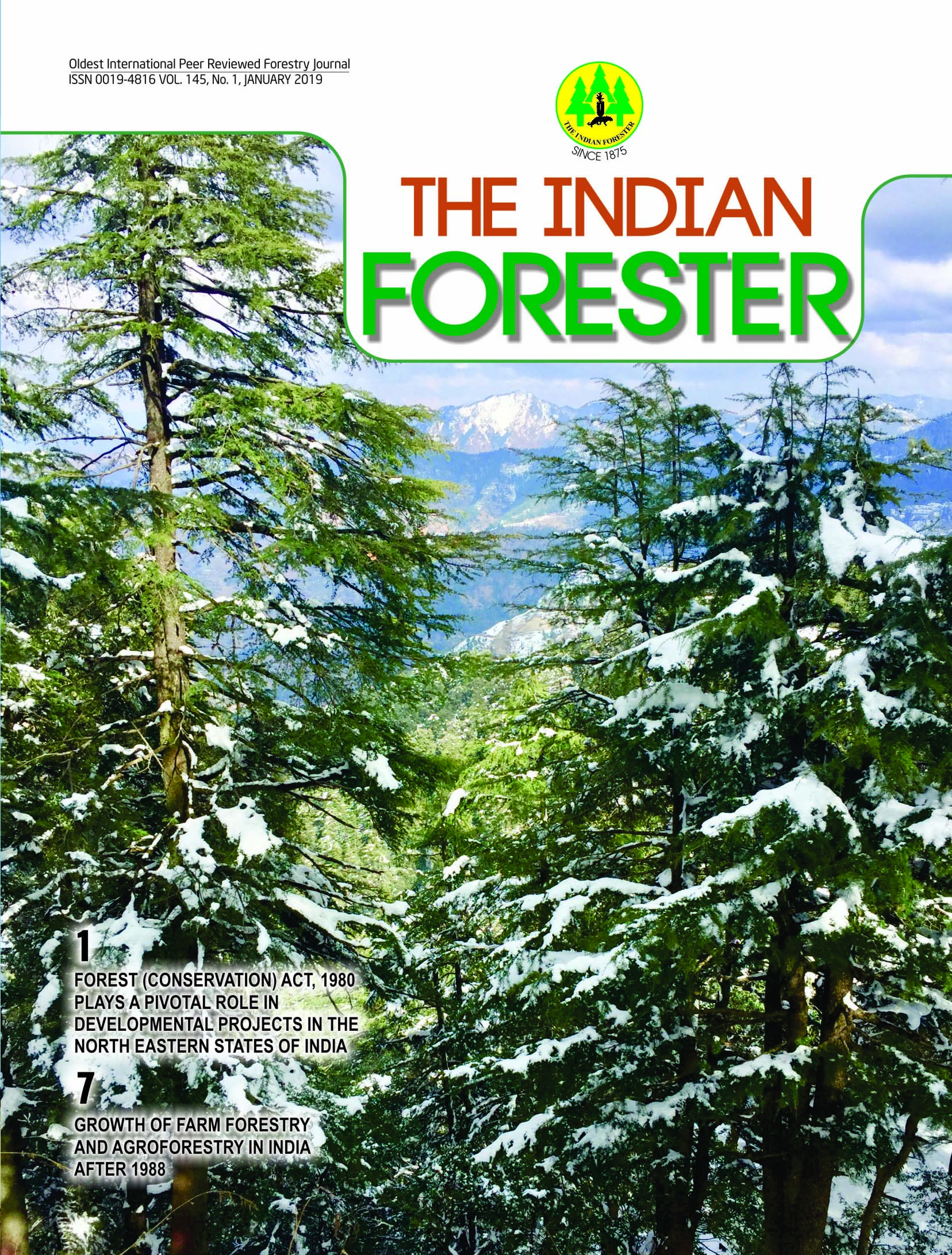Bamboo Based Agroforestry for Sustainable Utilization in Land under Shifting Cultivation of Assam
DOI:
https://doi.org/10.36808/if/2019/v145i1/122409Keywords:
Jhum, Intercropping, Agroforestry, Bambusa balcooa, Agricultural crop.Abstract
A field study was conducted intercropping agricultural crop with Bambusa balcooa for four consecutive years in Rongbonghat, Karbi Anglong district, Assam. Culm cutting of B. balcooa was planted in three different spacing trial (3x3m, 4x4m and 5x5m) intercropped with maize (Zea mays L.) and colocasia (Colocasia mannii Hook. f.) as per local demand of the people. Growth parameter of bamboo in solo plantation as well as intercropped with agricultural crops recorded remarkably more in 5x5m spacing during 4th year of experimentation. Highest numbers of newly emerged bamboo shoot and maize cob were recorded in 5x5m spacing. Yield of maize (22.89 qt/h) and colocasia (3.54 qt/h) was recorded less in the initial of year cultivation at 3x3m spacing, gradually increased in yield was observed subsequent year (maize-33.8 qt/h and colocasia-5.27 qt/h) up to third year cultivation at 5x5 spacing. Productivity of crops gradually declined after third year of cultivation due to profuse growth of bamboo and dense canopy cover which may causes the competition of nutrients and light between two growing crops.
Increments of soil nutrients also play key role for the production of crop yield and growth parameter of bamboo. At the initial stage, least value of pH, organic carbon and NPK was noticed in soil under intercropped plot, while it increases in successive year due to decomposition of maize straw, bamboo leaf and other crop biomass. Addition of root and shoot biomass also lowered acidity from initial level and enhance the soil fertility. Biomass retained the moisture content and creates a favorable environment for development of plant growth up to third year of cultivation and gradually declined due to prolific growth of bamboo. The present research work has been carried out to develop a bamboo based agroforestry to enhance the sustainable productivity of jhum land.
References
Behari B., Aggrawal R., Singh A.K. and Banerjee S.K. (2000). Vegetation development in a degraded area under bamboo based agro-forestry system. Indian Forester, 126 (7): 710720.
Bhatt B.P. and Laxminarayan K. (2010). Restoration of shifting cultivation areas through hedgerow species in eastern Himalaya, India. J. of Non Timber Forest Products, 17 (3): 261-266.
Bora I.P., Baruah A. and Kaushik P.K. ( 2013). Bambusa balcooa along with rhizome bearing plants as intercrops- a potential agroforestry practice in jhum land of Assam. J. of Non Tim. Forest Products, 20 (4): 233-238.
Borthakur D.N. (1992). Agriculture of Northeastern Region with Special Reference to Hill Agriculture. Beecee Prakashan Guwahati, India, 265 pp.
Dale V.H., Houghton R.A., Grainger A., Lug A.F. amd Brown S. (1993). Emission of green house gas from tropical deforestation and subsequent use of land. In : Proceedings National Research Council of Sustainable Agriculture and the environment in Humid Tropics Academic press, Washington DC. 215-260 pp.
McGrath D.A., Smith C.K., Gholz H.L. and de Assis Oliveira F. (2001). Effects of Land-Use Change on Soil Nutrient Dynamics in AmazoˆNia. Ecosystems, 4: 625–645.
Gogoi B. (2015). Soil productivity and socio economic development through agroforestry in North east India. Asian J. Sci. and Techno., 6 (12): 2048-2053
Jackson M.L. (1973). Soil Chemical Analysis. Prentice Hall of India Pvt. Ltd., New Delhi.
Kang B.T., Wilson G.F. and Sipkens L. (1981). Alley cropping maize (Zea mays, L) Leucaena Leucocephala (Lam.) in Southern Nigeria. Plant and Soil, 63: 165-179 Maithani K., Arunachalam A., Tripathi R.S. and Pandey H.N.
(1998). Nitrogen Mineralization as Influenced by Climate, Soil and Vegetation in a Subtropical Humid Forest in Northeast India. Forest Ecology and Management, 109: 91-101.
Ramakrishnan P.S. (1992). Shifting Agriculture and Sustainable Development: An Interdisciplinary Study from North- Eastern India. MAB series 10 Parthenon Press, UK.
Satapathy K. (2006). Run off production on hill slopes under different land use systems a case study. In: Agro forestry in North East India: Opportunities and Challenges (Bhatt, B.P., Bujarbaruah, K.M. eds.). ICAR Research Complex for NEH region, Umiam, Meghalaya, India, 437-445 pp.
Vanlalhluna P.C. (2007). Studies on tree-crop compatibility and growth performance of field crops and soil moisture conservation as affected by different mulches under hilly terrain of Mizoram. PhD. thesis, Mizoram University, India.
Vanlalhluna P.C. and Sahoo U.K. (2008). Management effect on crop yield in a Gmelina arborea based agroforestry system in humid tropic, of North east India. J. Hill Research, 21:13-19.
Vanlalhluna P.C., Sahoo U.K. and Lalfakzuala R. (2008). Observation on growth performance of some multipurpose trees in an agro forestry system of Mizoram, North East India. J. Nature Conservation, 20: 53-61.
Downloads
Downloads
Published
How to Cite
Issue
Section
License
Unless otherwise stated, copyright or similar rights in all materials presented on the site, including graphical images, are owned by Indian Forester.





